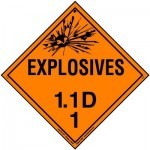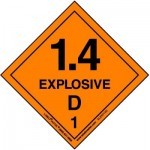In this business you just never know from what industry within the regulated community you might receive a question. Like this one from a person with whom I’d had no prior business; he contacted me through MY WEBSITE with a question on March 23, 2015:

I’m going to be loading gun carriers for the oilfield with shaped charges and det cord. My previous job with <<redacted>>, we were told by DOT when we transported our guns that we only needed to count the explosive weight and not the gun carrier itself (shipping container) What is the proper way to calculate the weight to transport perforating guns. Any information would be greatly appreciated.
My honest reply the next day (3.24.15):
That question is going to take a little research (and time). I have not yet had experience with DOT regulations for explosives, but am confident I can answer your question after digging into the regulations.
I’ll try to get you an answer later this week or early next.
True to my word, here’s my reply on March 30th:


- The packing instructions (US1 in Table of Packing Methods at 49 CFR 173.62) include limits on the weight of the explosive content at 1(b): “Each shaped charge affixed to the gun may not contain more than 112 g (4 ounces) of explosives.” and 1(e)(ii & iii): “A jet perforating gun classed as 1.4D may be transported by a private offshore supply vessel only when the gun is carried in a motor vehicle as specified in paragraph (d) of this packing method or on offshore well tool pallets provided that:
(i) All the conditions specified in paragraphs (a), (b), and (c) of this packing method are met;
(ii) The total explosive contents do not exceed 90.8 kg (200 pounds) per tool pallet;
(iii) Each cargo vessel compartment may contain up to 90.8 kg (200 pounds) of explosive content if the segregation requirements in §176.83(b) of this subchapter are met; and
(iv) When more than one vehicle or tool pallet is stowed “on deck” a minimum horizontal separation of 3 m (9.8 feet) must be provided.” Otherwise there are no references to weight in the packing instructions. So here, it is the weight of just the explosive content that matters and not the weight of the entire gun. There is no reference in US1 to inner, outer, or intermediate packaging, because the gun itself is considered to be the authorized packaging. - The placarding determination at 49 CFR 172.504 includes specific information about placarding explosives, but no reference is made to using the weight of the entire article (jet perforating gun) or just the explosive content. It is my opinion, absent of guidance from USDOT, that the weight of the entire article (jet perforating gun) would be considered when determining the need for displaying placards. More information on the topic of placarding this HazMat is contained later in this article.
- 49 CFR 172.202(a)(5)(i) for describing the total quantity of a HazMat on a shipping paper reads as follows: “For Class 1 materials, the quantity must be the net explosive mass. For an explosive that is an article, such as Cartridges, small arms, the net explosive mass may be expressed in terms of the net mass of either the article or the explosive materials contained in the article.” (emphasis mine) I believe the jet perforating guns are an article and therefore have the option to be described on the shipping paper by either the net mass of the entire article or just the explosive content. There are several USDOT letters of interpretation that confirm this interpretation:
I hope this helps. Please let me know if you have any other questions.
Thinking the issue resolved – another happy customer, right? – I sent this email on April 9, 2015:

With your permission I’d like to use the text of our emails (all names removed) as an article in my blog and newsletter.
Please let me know if that is OK.
The reply from my – not entirely satisfied – customer the next day (4.10.15):
Dan, as long as my name and the company name isn’t in there I don’t see a problem with it, maybe someone else can shed some light on the subject of net vs. gross explosive weight and placarding accordingly.
Thanks
Wait. What?! My reply on April 11, 2015:
I appreciate you letting me use the content of our emails. Does your email indicate that I did not answer your question entirely? I’d be more than happy to provide more information if you have any unanswered questions.
Still some unanswered questions (4.11.15):
Not entirely, I understand that most oilfield companies count gross weight which is the weight of the explosives and the weight of the gun barrels for placarding, at <<redacted>> we were told by somebody with dot that we only had to go by net explosive weight and not gross so we didn’t have to placard our vehicles even though we were carrying more than 1000 lbs gross weight.
OK, let me try that again (4.11.15):

I’ll research that question further and get you an answer next week.
My reply on April 22, 2015:
OK! I think I have the answer you are looking for and it is right in the regulations.
- It is a placard Table 2 HazMat.
- It is in a non-bulk packaging.
With the information you provided, my assumptions (see above), reference to 49 CFR 172.504(c), and a conversation with the PHMSA, I have determined that the entire weight of the explosive content and the gun itself (i.e. the aggregate gross weight) must be used when making the placarding determination for a vehicle.
My follow-up on May 7, 2015:
Contact me with any questions you may have about the transportation of hazardous materials by air, highway, vessel, or rail International and Domestic Daniels Training Services 815.821.1550 |
And now, finally, the satisfied customer I was hoping for! (5.7.15):
Thanks again
